
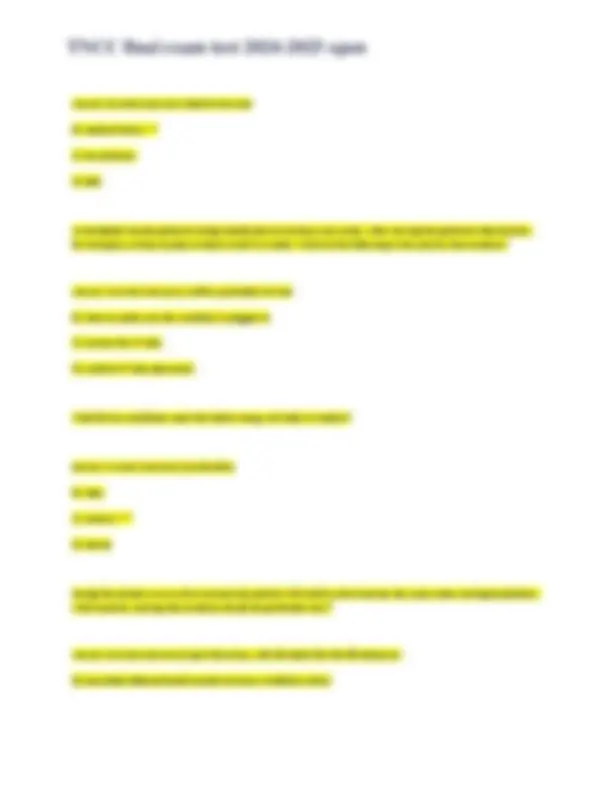
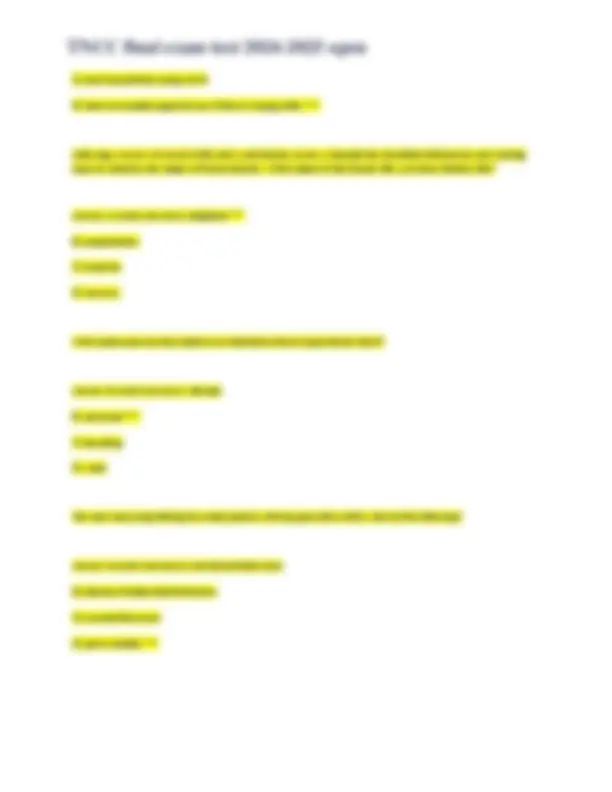
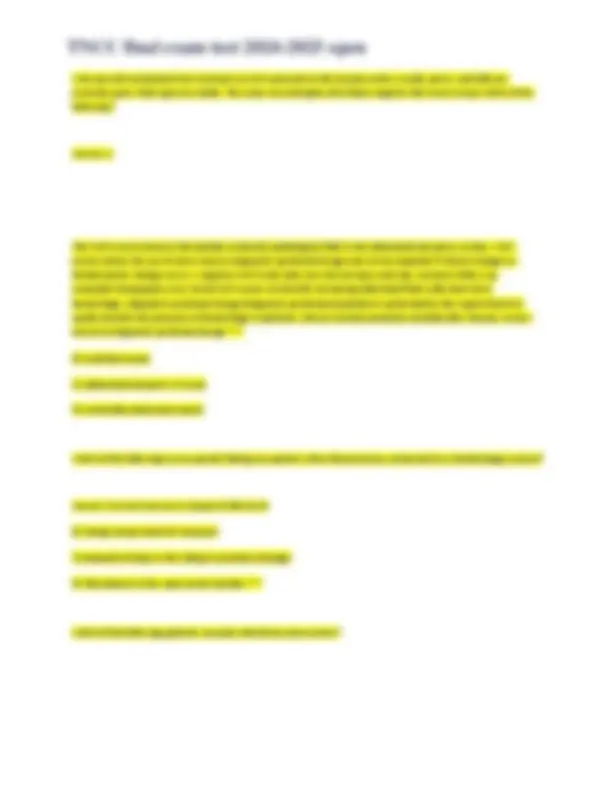
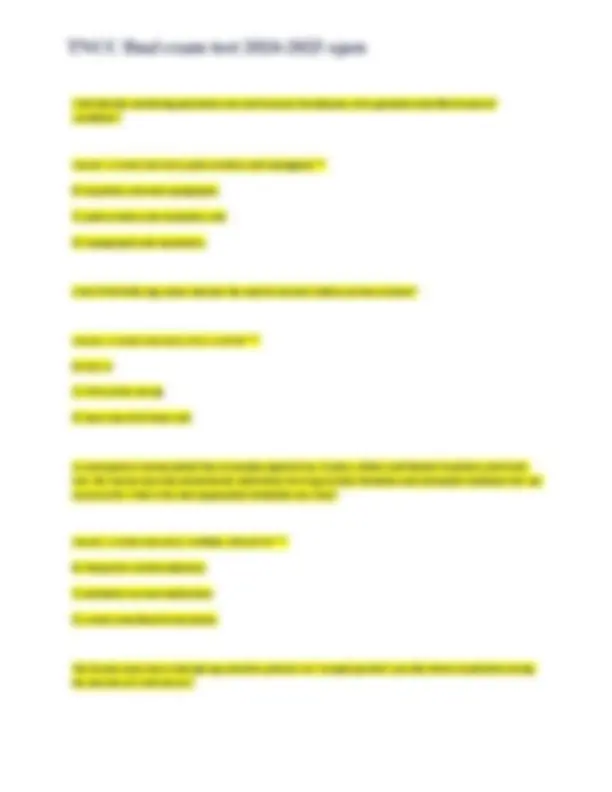
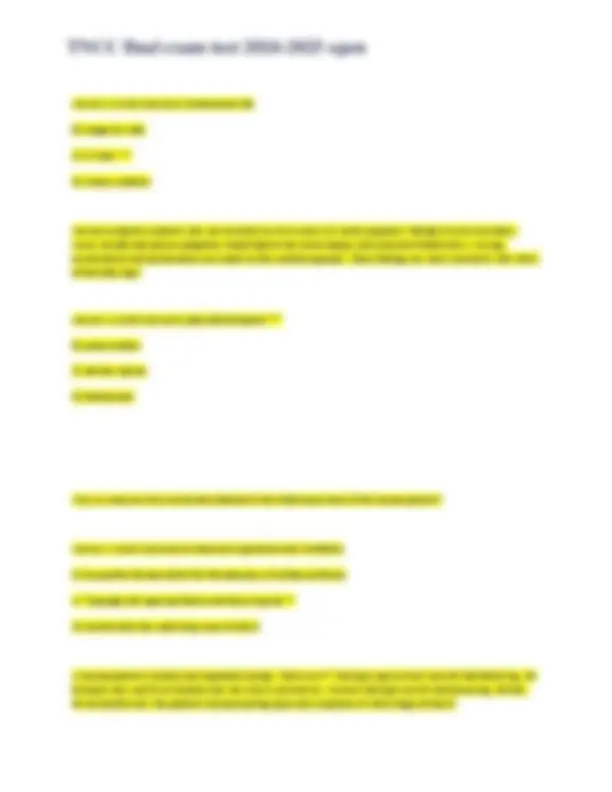
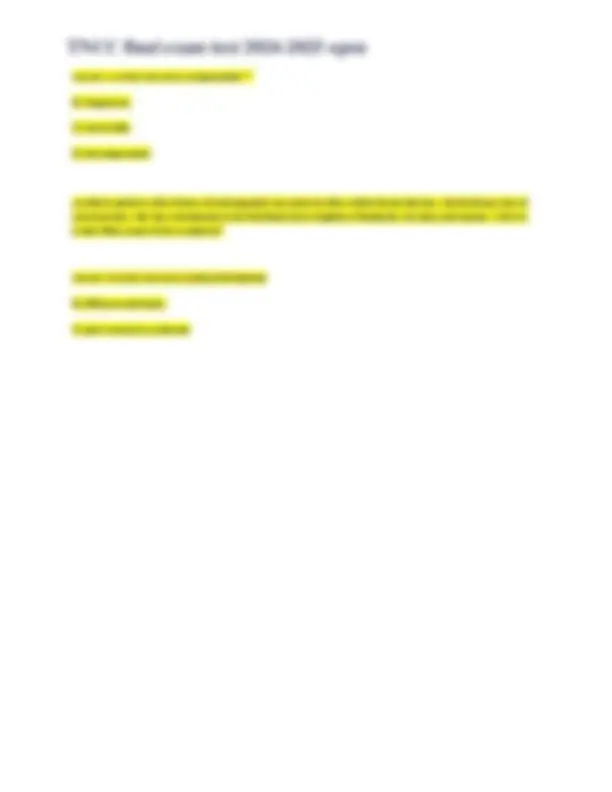
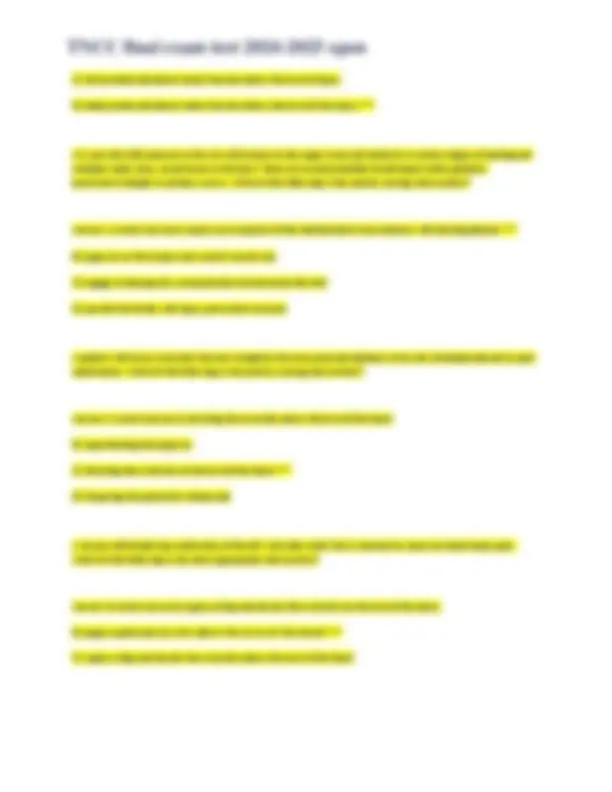
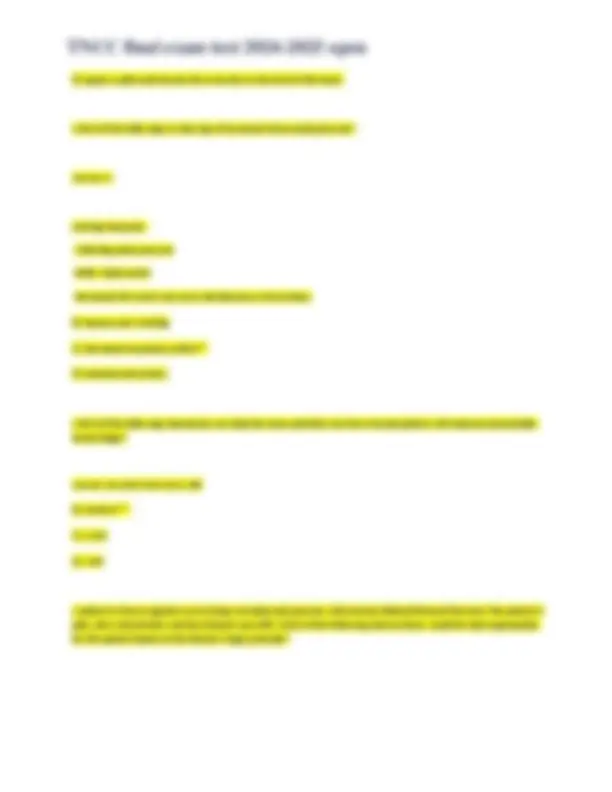
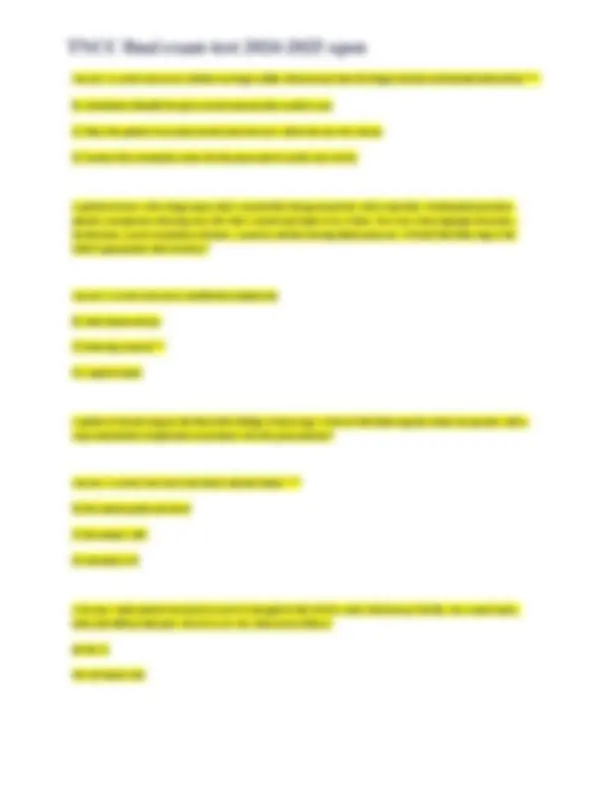



Study with the several resources on Docsity

Earn points by helping other students or get them with a premium plan


Prepare for your exams
Study with the several resources on Docsity

Earn points to download
Earn points by helping other students or get them with a premium plan
Community
Ask the community for help and clear up your study doubts
Discover the best universities in your country according to Docsity users
Free resources
Download our free guides on studying techniques, anxiety management strategies, and thesis advice from Docsity tutors
Multiple-choice questions and answers for trauma nursing, focusing on the TNCC final exam. Topics include fluid resuscitation, pneumothorax assessment, geriatric trauma, and hypothermia's impact on oxygen delivery. Correct answers are provided, aiding nurses preparing for the TNCC exam or enhancing trauma care knowledge. It covers disaster preparedness, shock management, and scenarios like burns, pelvic injuries, and pregnancy-related trauma. Designed to test understanding of key concepts and best practices, ensuring optimal trauma patient care. The open-book format suggests review and self-assessment, making it a valuable tool for evaluating comprehension and identifying areas for improvement.
Typology: Exams
1 / 18

This page cannot be seen from the preview
Don't miss anything!











If a patient has received multiple transfusions of banked blood preserved with citrate, which electrolyteis most likely to drop and require supplementation? Answer: D correct answerA) potassium
A trauma patient is en route to a rural ED. Radiology notifies the charge nurse that the CT scanner will beout of service for several of hours. The team gathers to plan accordingly. Which of the following terms best describes this trauma teams communication? Answer: D correct answerA) Brief
The nurse is caring for a 120 kg male is brought in after a warehouse fire and is calculating the patient'sfluid resuscitation needs. He has painful red blistering to the entire surface of both upper extremities and superficial burns to the anterior chest. Using the modified Lund and Browder chart to calculate thetotal BSA burned, how much IV fluids would be administered in the first 8 hours?
(upper arm 4+4 / lower arm 3+3 / hand 2.5+2.5) = 19% TBSA. 120 kg x (2 mL) x (19% TBSA) = 4560 mL 4560 / 2 (half of fluids given in first 8 hours) = 2280 mL Answer: A correct answerA) 2280 mL ***
Which of the following assessment findings differentiates a tension PTX from a simple PTX? answer: D Assessment findings associated with tension pneumothorax include anxiety, severe restlessness, severe respiratory distress, and absent breath sounds on the injured side. Hypotension due to compression of the heart and great vessels is consistent with obstructive shock. Hypotension worsens with inspiration due to increased intrathoracic pressure. Late signs include distended neck veins, tracheal deviation, andcyanosis. correct answerA) increased work of breathing
Which of the following considerations is most important when caring for a geriatric trauma patient?
Following a review of recent drills and a real disaster event, a hospital has identified deficiencies and is taking steps to minimize the impact of future disaster. Which phase of the disaster life cycle does this describe? Answer: A correct answerA) mitigation ***
Which pulse pressure description is an indication of early hypovolemic shock? Answer: B correct answerA) widened
The most reassuring finding for a male patient with hop pain after a fall is which of the following? Answer: D correct answerA) a normal prostate exam
A 49 - year old restrained driver involved in a MVC presents to the trauma center c/o abd, pelvic, and billower extremity pain Vitals signs are stable. The nurse can anticipate all of these negative fast exam except which of the following? Answer: A The FAST exam is done at the bedside to identify pathological fluid in the abdominal and pelvic cavities. FAST exams reduce the use of more invasive diagnostic peritoneal lavage and can be repeated if clinical changes or hemodynamic changes occur. A negative FAST study does not rule out injury and may warrant a follow-up computed tomography scan. Serial FAST exams can identify increasing abdominal fluid collections from hemorrhage. Diagnostic peritoneal lavage/diagnostic peritoneal aspiration is performed by the surgical team to rapidly identify the presence of hemorrhage in patients who are hemodynamically unstable after trauma. correct answerA) diagnostic peritoneal lavage ***
Which of the following is an expected finding in a patient with a thoracostomy connected to a chestdrainage system? Answer: D correct answerA) output of 200 mL/hr
Which of the following patients warrants referral to a burn center?
You are treating a 27 - year old male in respiratory distress who was involved in a house fire. CalculatingTBSA burned is deferred d/t the need for emergent intubation. At what rate should you begin fluid resuscitation? Answer: B correct answerA) 1000 mL/hr B) 500 mL/hr ***
Which of the following is possible complication of positive-pressure ventilation? Answer: A correct answerA) worsening pneumothorax
Which of the following is NOT considered goal-directed therapy of cardiogenic shock? Answer: C correct answerA) controlled fluid boluses
What bedside monitoring parameters are used to assess for adequacy of oxygenation and effectivenessof ventilation? Answer: A correct answerA) pulse oximetry and capnogaphy **
Which if the following values indicates the need for alcohol withdrawal interventions? Answer: A correct answerA) CIWA-Ar of 36 ***
An unresponsive trauma patient has an oropharyngeal airway in place, shallow and labored respiratory,and dusky skin. the trauma team has administered medications for drug assisted intubation and attempted intubation but was unsuccessful. What is the most appropriate immediate next step? Answer: A correct answerA) Ventilate with a BVM ***
The trauma nurse knows that placing a bariatric patients in a "ramped position" provides bettervisualization during the insertion of which device?
Answer: A correct answerA) compensated **
An elderly patient with a history of anticoagulant use presents after a fall at home that day. she deniesany loss of consciousness. She has a hematoma to her forehead and complains of headache, dizziness,and nausea. Which is a most likely cause of her symptoms? Answer: D correct answerA) epidural hematoma
EMS brings a patient who fell riding his bicycle. Using the American College of Surgeons screening guidelines, which assessment finding would prompt the nurse to prepare the patient for radiologic spineclearance? Answer: D correct answerA) Alert with no neurologic deficits
Which of the following occurs during the third impact of a motor vehicle crash? Answer: C correct answerA) The driver of the vehicle collides with the steering wheel
A passenger is brought to the emergency department of a rural hospital following a high-speed MVC. When significant abdominal and pelvic injuries are noted in the primary survey, which of the following isthe priority interventions? Answer: A correct answerA) initiate transfer to a trauma center **
A 5-year old child presents to the ED with bruises to the upper arms and buttocks in various stages of healing and multiple small, clean, round burns to the back. There are no abnormalities found based onthe pediatric assessment triangle or primary survey. Which of the following is the priority nursing intervention? Answer: A correct answerA) report your suspicion of the maltreatment in accordance with localregulations ***
A patient with lower extremity fracture complains of severe pain and tightness in his calf, minimallyrelieved by pain medications. Which of the following is the priority nursing intervention? Answer: C correct answerA) elevating the extremity above the level of the heart
A 36 - year old female has a deformity of the left wrist after a fall. She is reluctant to move her hand dueto pain. Which of the following is the most appropriate intervention? Answer: B correct answerA) apply a sling and elevate the extremity to the level of the heart.
Which of the following is a late sign of increased intracranial pressure? Answer: C Cushing Response Widening pulse pressure Reflex bradycardia Decreased RR correct answerA) Restlessness or drowsiness
Which of the following mnemonics can help the nurse prioritize care for a trauma patient with massiveuncontrolled hemorrhage? Answer: B correct answerA) ABC
A patient is thrown against a car during a tornado and presents with obvious bilateral femoral fractures.The patient is pale, alert, disoriented, and has delayed cap refill. Which of the following interventions would be most appropriate for this patient based on the disaster triage principle?
RR 26 breaths/min SpO2 94% on high flow O2 via NRB mask which of the following is the priority intervention for this patient? Answer: C correct answerA) Expedite transport to the CT scanner
Caregivers carry a 2 - year old into the ED who fell out of 2nd story window. The patient is awake and crying with increased work of breathing and pale skin. which of the following interventions has the highest priority? Answer: A correct answerA) padding the upper back while stabilizing the cervical spine ***
Which of the following is a component of the trauma triad of death? Answer: A hypothermia, metabolic acidosis, coagulopathy correct answerA) Acidosis **
A 35 - year old male presents with facial trauma after bring struck inthe face with a baseball. a tear-dropshaped left pupil is noted on exam. What type of injury is suspected? Answer: B correct answerA) oculomotor nerve palsy
Which of the following is true about the log roll maneuver? Answer: C correct answerA) it causes less spinal motion than the lift and slide manuever
EMS arrives with the intoxicated driver of a car involved in a MVC. EMS reports significant damage to the drivers side of the car. The patient is asking to have the cervical color removed. when is it appropriate to remove the cervical collar? Answer: A correct answerA) after a physical examination if the patient has no radiologic abnormalities on a computed tomography scan ***